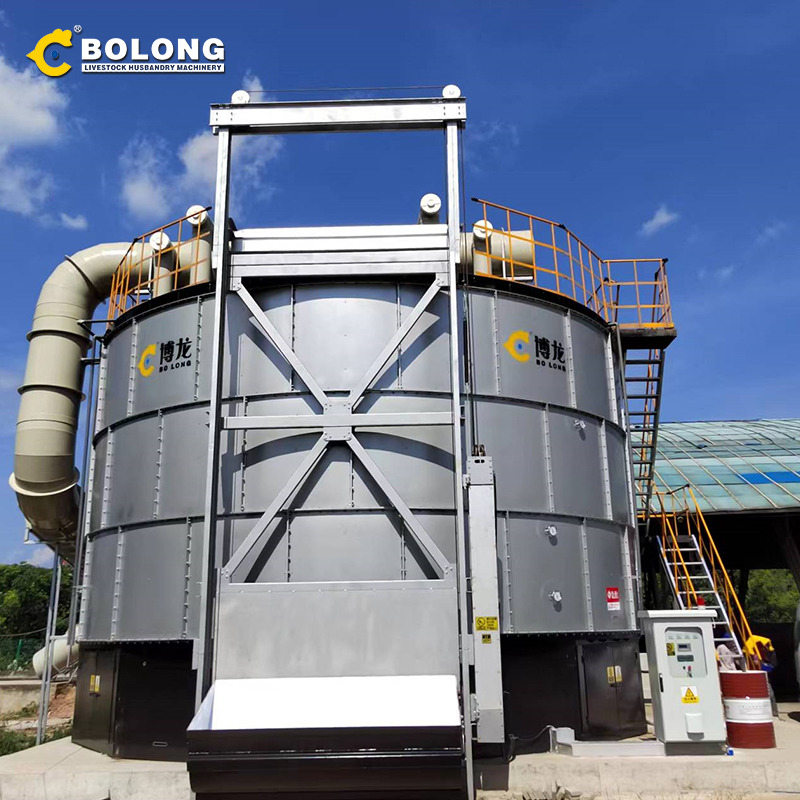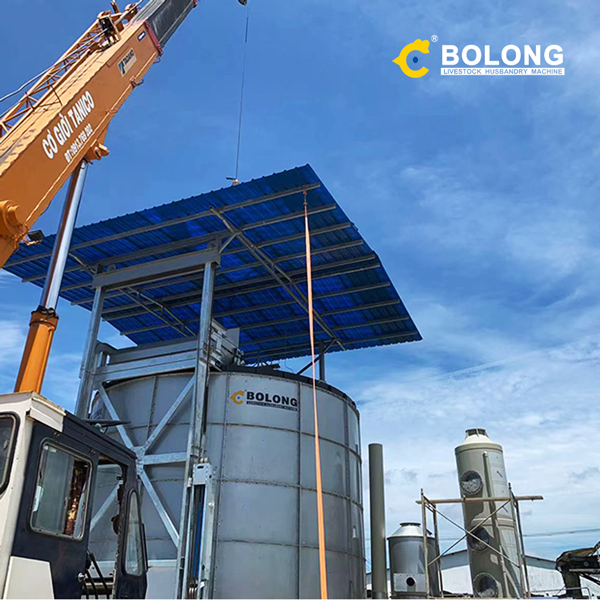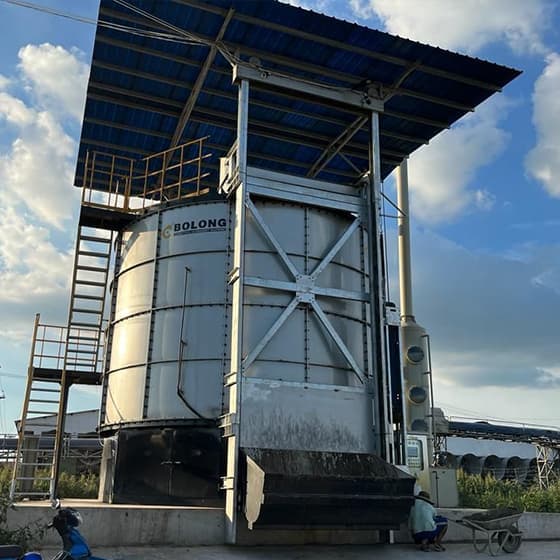With the continuous advancement of industrialization, especially the rapid development of food processing, environmental protection, medicine and other industries, the fermentation process, as the core link in many biological manufacturing processes, also plays an important role in the increasingly complex production environment. However, the odor and harmful gases generated by the composting machine during the production process have become an environmental problem that cannot be ignored. This not only affects the air quality of the surrounding environment, but also may threaten the health of employees. Therefore, how to effectively control and reduce the odor emission of the composting machine has become the focus of industry attention. In recent years, the innovation of composting machine deodorization technology is increasingly becoming an important way to solve this problem.
composting machine fermentation is a process in which organic matter is converted into the desired product through the action of microorganisms. In this process, microorganisms not only generate target products, but also release a large amount of gases, such as carbon dioxide, ammonia, hydrogen sulfide and organic acids. These gases are usually highly irritating and malodorous, especially hydrogen sulfide and ammonia, which may even cause harm to the environment and human health at high concentrations.
During the fermentation process in some composting machines, the decomposition of proteins or amino acids releases ammonia, which has a strong pungent smell.
Sulfide production: Sulfur sources in some fermentation processes, such as thiocyanate or sulfur-containing organic matter, are easily metabolized by microorganisms to generate hydrogen sulfide with a foul odor.
Some volatile organic acids generated during the fermentation process may also be released into the air in the form of gas, increasing the concentration of odor in the air.
These odors not only affect the air quality of the environment around the composting machine, but may also cause discomfort to the staff in the production workshop, affect production efficiency, and even cause health hazards in some cases. Therefore, the development and application of efficient deodorization technology has become the focus of major companies and scientific research institutions.

In recent years, with the continuous advancement of technology, composting machine deodorization technology has also undergone many innovations. Existing deodorization technologies mainly include physical methods, chemical methods, and biological methods. The combination and innovation of various technologies have gradually improved the deodorization effect, and the deodorization efficiency and energy saving and environmental protection have also been significantly improved.
Biological deodorization technology is to achieve deodorization through the metabolism of microorganisms and their ability to degrade harmful gases. This method has the advantages of being green and environmentally friendly, and simple to operate. It is particularly suitable for the treatment of organic gases produced in composting machines.
Biofilter: The biofilter uses the degradation ability of microorganisms in the biofilm to remove odors from the air. When the waste gas in the composting machine passes through the filter, the harmful substances in the gas are adsorbed and decomposed by the microorganisms. This method can not only remove odors such as hydrogen sulfide and ammonia, but also effectively reduce the emission of greenhouse gases such as carbon dioxide.
Bioscrubber: The bioscrubber forms a microbial community in the water by contacting the waste gas with the water flow, and uses the water-soluble gas to be degraded under the metabolism of microorganisms. This method has a good treatment effect, especially for treating waste gas from composting machines with more moisture.
In recent years, the research on biological deodorization technology has made significant progress, especially in the treatment effect of specific odor molecules . Many breakthroughs have been made. The use of engineered microbial communities or genetically engineered microorganisms can make the deodorization effect more significant and more stable.
Chemical deodorization technology mainly relies on chemical reactions such as adsorption, oxidation-reduction, and catalytic reactions to remove odors produced by composting machines. These technologies can remove specific gas molecules in a targeted manner, so they have been widely used in some specific industries.
Activated carbon adsorption: Activated carbon is widely used in composting machine deodorization due to its strong adsorption. Activated carbon can effectively adsorb malodorous gases such as ammonia, hydrogen sulfide, benzene and other substances in the air, and the removal effect is quite significant. With the in-depth research on activated carbon surface modification technology, the adsorption performance of activated carbon has been further improved.
Catalytic oxidation technology: Catalytic oxidation technology accelerates the oxidation and decomposition of harmful substances in odor through the action of catalysts. For example, for ammonia, catalysts such as aluminum oxide and palladium can be used to oxidize ammonia into harmless nitrogen and water. Catalytic oxidation technology has a high processing efficiency and is suitable for large-scale applications.
Physical deodorization technology removes odor from the air through physical means such as filtration and adsorption. In recent years, with the development of filtration material technology, new high-efficiency filters, photocatalytic materials, etc. have been applied to the deodorization system of composting machines, which has improved the efficiency and stability of deodorization.
High-efficiency filtration system: Through high-efficiency filter materials (such as polypropylene, polyester fiber, etc.), large particulate matter and gas impurities in the exhaust gas are filtered out, effectively reducing the emission of odor. With the development of nanotechnology, the application of nano-scale materials has greatly improved the accuracy of air filtration.
Ozone oxidation: Ozone has strong oxidizing properties and can be used to decompose organic gases and remove odorous components in composting machine gases. Ozone oxidation treatment has the advantages of fast processing speed and high efficiency, and has been used in some composting machine deodorization systems.

With the increasingly stringent environmental protection regulations and the public’s attention to air quality, the innovation of composting machine deodorization technology will face higher requirements. The future development direction may focus on the following aspects:
Integrated technology: A single deodorization technology is often difficult to meet all the requirements of composting machine waste gas treatment. Therefore, integrated technical solutions will become the mainstream. This solution combines different deodorization technologies to achieve efficient removal of multiple odors.
Intelligent management: With the development of the Internet of Things and artificial intelligence, the deodorization system of the composting machine can realize intelligent monitoring and adaptive adjustment, further improve the deodorization efficiency and reduce energy consumption.
Low-carbon and environmentally friendly technology: In the future, composting machine deodorization technology will pay more attention to energy saving and consumption reduction, and reduce carbon emissions in the process of waste gas treatment. The application of green catalysts, energy recovery and other technologies will make composting machine deodorization technology more environmentally friendly and economical.

The innovation of composting machine deodorization technology has greatly promoted the process of environmental protection and sustainable development in industrial production. With the continuous upgrading of technology, we have reason to believe that composting machine deodorization technology will be more efficient, economical and environmentally friendly in the future, bringing greater environmental benefits and social value to enterprises and society.